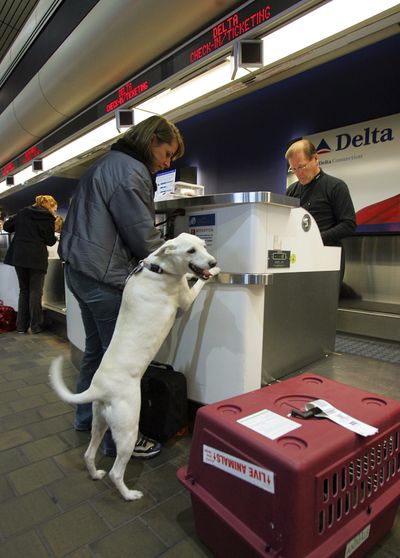Fido in first class? Only if he weighs less than 20 pounds
Packing your pets for air travel? There are some guidelines you’ll want to follow

We dress them up. We feed them gourmet foods. We treat them like members of the family.
So when we have to fly – whether it be on a beach vacation or to grandma’s house – our pets are often a first-class priority.
Bringing animals on flights has become more commonplace in recent years, but some airlines can be more pet-friendly than others.
AirTran, Spirit and JetBlue only allow pets to fly in the cabin. That’s great for animal lovers who argue that precious pets shouldn’t be relegated to the cargo hold – but not so great for owners with medium or large dogs.
Pups in the cabin must be able to fit (read: stand up and turn around) in a carrier small enough to slide under the seat in front of you during flight. Generally, this maxes out at about 20 pounds.
JetBlue is the only U.S. airline that allows animals in the cabin on international flights. As a bonus, you’ll also earn extra frequent flier points for traveling with your pet.
For pets traveling in the cabin, AirTran charges the least among big carriers at $69. Most U.S. airlines charge between $100 and $125, but bringing a pet in the cabin on Delta and Northwest flights costs $150.
For those traveling as checked baggage, Delta and Northwest are the most expensive at $275. The least expensive in this category are Alaska Airlines and Midwest, at $100, and Frontier, which prices its checked pets fees between $100 and $200.
Frontier only allows pets as checked baggage. Southwest doesn’t allow pets at all, except for service animals.
In all cases, the airlines won’t charge you a first or second bag fee for your dog on top of the pet fee. But some airlines will count the kennel as a piece of checked luggage, so if you have more than two bags, you might get slammed with another fee.
Aside from the fees, traveling with a pet can sometimes be a frustrating and even scary experience. Although it’s rare, a handful of pets get lost or killed each year when traveling on airlines.
While some incidents can’t be avoided, preparation, experts say, is the key to having a safe and uneventful flight.
Here are some basic tips to ensure happy trails in the air:
•Make sure your pet is fit to fly. Have a veterinarian examine your pet and give a clean bill of health before the flight. Most airlines require health certificates. You may also have to bring along vaccination records.
•If you have a snub-nosed dog or cat, like a pug or Persian, check with your vet to make sure they can fly. Some of these types of animals have breathing troubles that could be complicated at high altitudes.
•Consider microchipping your pet. The device, about the size of a grain of rice, can be implanted for less than $100. And because the process gives the pet a unique ID that can be accessed if your cat or dog gets lost, chances of finding them can grow exponentially. Also make sure all tags and licenses are up-to-date with your most recent address and contact number.
•Try to choose a less hectic time to travel to avoid stress on your animal. Weekdays are ideal. Choose a nonstop flight whenever possible.
•If you are flying during the summer and your pet is traveling in cargo, try to schedule the flight in the early morning or evening, when temperatures are lowest. If you’re heading out in the winter, aim for a midday flight. Because the temperature in the cargo areas can be extreme, most carriers only allow pets on board if the air temperature is greater than 45 degrees or less than 85.
•Let the airline know you are traveling with a pet when you book, so you can make sure there is room for your dog or cat onboard. There are limits on the number of pets that can be onboard a flight, ranging from three to seven, depending on the airline and size of the jet.
•Don’t feed your pet two hours before departure, to ensure it will be comfortable with the lack of potty breaks ahead. Try freezing water in a dish to fit in the carrier so it will melt gradually during flight and avoid spillage.
•Exercise with your pet a couple of hours before the flight to tire them out and help them relax. Adam Goldfarb, Director of Pets at Risk program at the Humane Society, recommends against the use of sedatives because the pet won’t be able to protect itself if the carrier shifts during flight; pets can also have reactions to the sedatives. Sedation can be especially dangerous for those breeds already prone to breathing problems.
•Secure pertinent information to your pet carrier such as the flight number, destination and your pet’s name and age if they are traveling below deck. “Live Animal” and “This End Up” stickers are recommended by the American Humane Association. Carry a recent photo in case your pet gets lost.
•Consider putting a harness on your cat if it won’t be with you in the cabin. If security personnel remove the cat from the carrier it will lessen the chance the cat will get loose.
There are other options popping up for pet lovers looking for a more comforting experience.
Pet Airways, which launches in July, will send your pet between major cities including New York, Washington D.C., Chicago, Denver and Los Angeles for $250 one-way (introductory fare of $150).
Dogs and cats will fly in a main cabin where seats have been replaced by kennels, and pets will be escorted to the animals-only flight by attendants that will monitor them during flight.